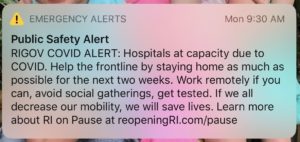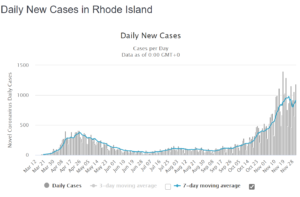I knew that Governor Gina Raimondo had announced a two week pause starting November 30th and that there were growing concerns about hospital capacity here in Rhode Island. But when I got this alert  pushed to my phone Monday morning like everyone else in the state, it became very real again.
pushed to my phone Monday morning like everyone else in the state, it became very real again.
I knew there was discussion about opening a field hospital in Rhode Island. But when I saw that the lead story on one of the national morning news shows was an interview with the field hospital director on opening day December 1st, it became very real again.
I knew that our ED at the largest hospital in the state was at a breaking point as I have been following Dr. Megan Ranney closely on social media in recent weeks. But when I heard her describe what it is like in the ED on this week’s In the Bubble podcast with Andy Slavitt – “Following One Shift in the COVID-19 Unit”, it became very real again. Listening to her describe mentally getting ready for her shift, donning and doffing layers of PPE that is worn the entire shift, assessing and admitting very sick patients, calling families with updates, and heading out the door with her physically exhausted co-workers at the end of a long shift, I came to appreciate even more what our frontline healthcare workers are doing 24×7 in hospitals across the country.
I am not a denialist. Quite the opposite. I have taken this virus seriously since the start. I wear a mask whenever I’m out and can’t be socially distanced. I keep a journal of all our outings and contacts. I have the Crush Covid RI app that includes a location tracker diary for the past 20 days on my phone. I have watched many news stories, read many articles, and listened to many podcasts in the past 9 months. I feel very educated and informed. And at times, I feel very sad – so many stories have brought me to tears.
When I hear about new restrictions in my state, I typically tell my husband no change for us, we’re already living that way.
But it hit me different this week. During the March and April surge in the Northeast, we talked about flattening the curve. We wanted to make sure there were hospital beds for people who needed them and that we didn’t overwhelm the health system.
Rhode Island is a small state in population and geography – just over one million people and only 1,212 square miles – but the second most densely populated state after New Jersey. Compared to the other 50 states, we have been #1 in tests per 1M population since the beginning – a positive! But we are #14 in total cases and #6 in deaths per 1M population – two negatives! While the surge in the Spring was nothing like Massachusetts and the tri-state area, the current surge is significant with a 7-day moving average peak of 977 new cases just two days before Thanksgiving. (Source: Worldometers)
And as Dr. Ranney described on the podcast, multi-generational households, immigrants, and essential workers are some of the most impacted.
Across the country, our hospitals have done an incredible job ensuring they are safe for all health needs since re-opening to all services. But if there is no capacity, there is no capacity for any other kind of emergency or hospitalization either. And patients who would normally be admitted will be sent home.
The Twitter thread from Dr. Ashish Jha, Dean of the Brown University School of Public Health, that is referenced in this Providence Journal article makes that crystal clear.
The number of COVID-19 patients in the hospital has just surpassed 100,000 for the first time – nearly double the number in the spring. A recent New York Times article by Reed Abelson, “Covid Overload: U.S. Hospitals Are Running Out of Beds for Patients”, talks about both the shortage of beds and the shortage of staff.
Hospitals from senior executives to staff nurses are sounding the alarm. We owe it to them to listen. And we owe it to each other to listen – we are all in this together.
The #Maskup campaign by well over 100 health systems is great but long overdue. According to the current map at #Masks4All only one state, South Dakota, has no known mask requirements while 13 states have some or limited mask requirements. 36 states have mask requirements across the entire state – happy to say I live in one of them.
Wearing a mask to protect yourself and others is a simple thing to do and nothing compared to the layers of PPE that our healthcare workers on the frontline wear for an entire shift.
Yes, the vaccine is coming but we can’t let our guard down.
Be well. Be strong. Be smart.
Related Post:

